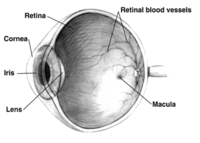
Photo from wikipedia
Neurons typically receive synaptic input in their dendritic arbor, integrate inputs in their soma, and send output action potentials through their axon, following Cajal’s law of dynamic polarization. Two notable… Click to show full abstract
Neurons typically receive synaptic input in their dendritic arbor, integrate inputs in their soma, and send output action potentials through their axon, following Cajal’s law of dynamic polarization. Two notable exceptions are retinal amacrine cells and olfactory granule cells (GCs), which flout Cajal’s edict by providing synaptic output from the same dendrites that collect synaptic input. Amacrine cells, a diverse cell class comprising >60 subtypes, employ various dendritic input/output strategies, but A17 amacrine cells (A17s) in particular share further interesting functional characteristics with GCs: both receive excitatory synaptic input from neurons in the primary glutamatergic pathway and return immediate, reciprocal feedback via GABAergic inhibitory synapses to the same synaptic terminals that provided input. Both neurons thereby process signals locally within their dendrites, shaping many parallels, signaling pathways independently. The similarities between A17s and GCs cast into relief striking differences that may indicate distinct processing roles within their respective circuits: First, they employ partially dissimilar molecular mechanisms to transform excitatory input into inhibitory output; second, GCs fire action potentials, whereas A17s do not. Third, GC signals may be influenced by cortical feedback, whereas the mammalian retina receives no such retrograde input. Finally, A17s constitute just one subtype within a diverse class that is specialized in a particular task, whereas the more homogeneous GCs may play more diverse signaling roles via multiple processing modes. Here, we review these analogies and distinctions between A17 amacrine cells and granule cells, hoping to gain further insight into the operating principles of these two sensory circuits.
Journal Title: Frontiers in Cellular Neuroscience
Year Published: 2020
Link to full text (if available)
Share on Social Media: Sign Up to like & get
recommendations!